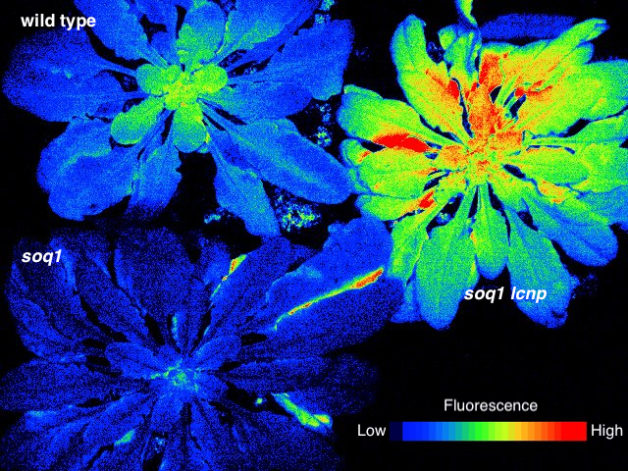For plants, light is great, until it’s not. They need the sun’s energy to carry out photosynthesis, but too much light damages the chloroplasts in plant cells where light, water, and carbon dioxide are converted into sugar and oxygen. One way plants protect themselves is to dissipate that excess light, a process that also occurs in the chloroplasts.

After a cold and high light stress, thale-cress plants (wild-type and soq1) display less chlorophyll fluorescence, equivalent to more energy dissipation. Researchers found that mutant plants with deficient levels of the lipocalin protein (soq1 lcnp) display high chlorophyll fluorescence. This indicates that LCNP is required for energy dissipation. (Credit: Alizée Malnoë/Berkeley Lab)
Researchers at the Department of Energy’s Lawrence Berkeley National Laboratory (Berkeley Lab) are working to understand – and manipulate – plant photoprotection mechanisms, such as a process called NPQ, or nonphotochemical quenching, which helps dissipate excess light energy inside chloroplasts.
Previous studies have found proteins and cellular factors involved in rapid-response energy dissipation when light intensity suddenly changes, such as when clouds move past the sun. Much less had been known about the proteins and factors that respond slowly, and whether they promote protection against light.
A new study by Berkeley Lab researchers has shed light on this with the discovery of a lipocalin protein (LCNP) in chloroplasts that is required for energy dissipation in the NPQ process.
“This chloroplast protein is necessary for a sustained type of photoprotection,” said study principal investigator Krishna Niyogi, a faculty scientist in Berkeley Lab’s Molecular Biophysics and Integrated Bioimaging Division. “It presents a promising target for research into techniques that could help improve plant photosynthesis and crop yields.”
For the study, published last week in the journal The Plant Cell, the researchers used as a starting point Arabidopsis soq1, a mutant thale-cress plant that displays an enhancement of a slowly reversible form of energy dissipation. A genetic approach allowed the researchers to tease apart the molecular players involved in this process.
“We first found that mutants deficient in the lipocalin protein no longer performed this type of dissipation,” said study lead author Alizée Malnoë, a postdoctoral researcher at Berkeley Lab. “We then showed that this slower energy dissipation process is active in wild-type plants under stress conditions, such as cold and high light, and that it limits oxidative damage to lipids. The lipocalin protein is a plant’s alternative to sunscreen.”
The researchers said this process might be dominant in plants that experience long-term high light stress combined with other environmental stressors, such as drought or cold temperatures. They are continuing to study how this energy dissipation process is turned on and off, and whether manipulation of light usage by plants could ultimately lead to higher crop yields.
Both Niyogi and Malnoë also have appointments at UC Berkeley’s Department of Plant and Microbial Biology.
The work was supported by the DOE Office of Science.
###
Lawrence Berkeley National Laboratory addresses the world’s most urgent scientific challenges by advancing sustainable energy, protecting human health, creating new materials, and revealing the origin and fate of the universe. Founded in 1931, Berkeley Lab’s scientific expertise has been recognized with 13 Nobel Prizes. The University of California manages Berkeley Lab for the U.S. Department of Energy’s Office of Science. For more, visit www.lbl.gov.
DOE’s Office of Science is the single largest supporter of basic research in the physical sciences in the United States, and is working to address some of the most pressing challenges of our time. For more information, please visit science.energy.gov.
